| Article ID | Journal | Published Year | Pages | File Type |
|---|---|---|---|---|
| 3254096 | Best Practice & Research Clinical Gastroenterology | 2015 | 12 Pages |
Conventional adenomas were traditionally thought to be the only precursors to colorectal cancer (CRC). Nowadays, also serrated polyps are acknowledged as precursor lesions for CRC, responsible for up to 30% of all CRCs and probably a larger percentage of interval CRCs after colonoscopy. In recent years, much research is being done to unravel the serrated neoplasia pathway. Endoscopic detection of serrated polyps is still a challenge for gastroenterologists, which is illustrated by large variations in detection rates of serrated polyps in the proximal colon. Clinical practice is further inhibited by poor optical differentiation of SSA/Ps from conventional adenomas and HPs and difficult delineation of those lesions, resulting in incomplete resection. The main focus of this review is to highlight recent advancements in endoscopic imaging techniques with regards to detection, differentiation and resection of serrated polyps.
